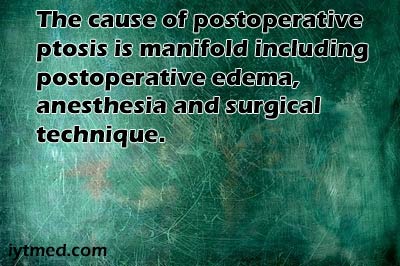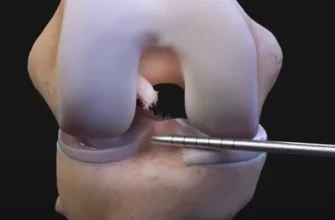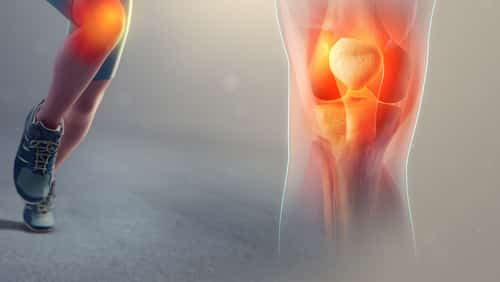Ptosis after Cataract Surgery
Published by January 3, 2016 Modified by December 16, 2023
Discover the causes, symptoms, and treatment options for ptosis after cataract surgery. Learn how to manage this condition for optimal eye health and aesthetics.
Information verified by the
iytmed.com team.
Overview of Ptosis after Cataract Surgery Cataract surgery is a common procedure to restore vision. Postoperative ptosis is a potential complication affecting eyelid position. Ptosis after cataract surgery may impact vision and aesthetic appearance. It involves the drooping of the upper eyelid covering part of the pupil. Common causes of Ptosis after Cataract Surgery Local anesthetic, used during surgery, can temporarily weaken the eyelid muscles. The surgical process may inadvertently damage the levator muscle responsible for lifting the eyelid. Swelling or trauma from the surgery can contribute to ptosis. Pre-existing eyelid conditions or muscle weakness may be exacerbated post-surgery. The healing response varies among individuals, which may lead to ptosis development. Understanding Ptosis Definition and causes of Ptosis Ptosis is identified as the drooping of one or both upper eyelids. The condition may obstruct visual function and affect facial symmetry. It can be congenital or acquired, with various underlying causes. Neurogenic, myogenic, aponeurotic, and mechanical factors can lead to ptosis. In the context of cataract surgery, it usually concerns aponeurotic ptosis. Age-related changes may influence the occurrence and severity of post-surgical ptosis. Patients with a history of multiple eyelid or ocular surgeries are at increased risk. Different types of Ptosis Neurogenic ptosis results from issues with the nerve pathways controlling eyelid muscles. Myogenic ptosis stems from diseases affecting the muscles that elevate the eyelid. Aponeurotic ptosis is often related to aging or disinsertion or stretching of the levator muscle’s aponeurosis. Mechanical ptosis arises when the eyelid is weighed down by a mass or excess skin. It is crucial for ophthalmologists to differentiate among types for effective management. Treatment options can vary from observation and ptosis crutches to corrective surgery. Cataract Surgery and Ptosis Relation between Cataract Surgery and Ptosis Cataract surgery involves manipulations near the levator muscle, potentially impacting eyelid function. Postoperative ptosis can result from surgical trauma or prolonged use of a speculum. The incidence of ptosis post-cataract surgery varies, but it is a recognized complication. Swift identification post-surgery ensures better prognoses after ptosis treatment. Factors contributing to Ptosis after Cataract Surgery The surgical technique and experience of the surgeon may influence ptosis risk. Inflammatory reactions from the surgery can weaken the eyelid’s supporting structures. Pre-existing conditions like dry eye or a weaker levator muscle increase ptosis susceptibility. Use of local anesthesia has been correlated with higher rates of ptosis post-surgery. Protective measures and careful surgical techniques can mitigate ptosis development. Symptoms and Diagnosis Signs and symptoms of Ptosis after Cataract Surgery Patient may report difficulty keeping their eyelid open or experience a heavy sensation in the lid. Visual field may become partially obscured by the drooping eyelid, affecting daily activities. An apparent change in the appearance of the eye, with one eyelid sitting lower than the other. Increased tiredness or strain in the muscles around the eyes due to compensatory efforts to lift the eyelid. Methods of diagnosing Ptosis Clinical evaluation usually includes a detailed examination of eyelid position, movement, and strength. Measurement of the eyelid fissure and levator function to assess the severity of ptosis. Imaging tests like an MRI or CT scan may be ordered if there’s suspicion of underlying issues. Patient’s medical history and reports of symptoms are considered to identify the cause of ptosis. Ophthalmologists may use specific tests like a phenylephrine test to distinguish between types of ptosis. Treatment Options Conservative treatment measures for Ptosis Eyelid exercises may be suggested to strengthen the muscles if the ptosis is mild. Application of prescription eye drops that stimulate eyelid muscles. Use of special glasses or crutches that hold the eyelid up externally. Adjusting daily activities to alleviate symptoms, such as avoiding looking downward for prolonged periods. Surgical options for correcting Ptosis Blepharoplasty: A procedure that involves the removal of excess eyelid skin and fat. Levator resection: A surgery aimed at shortening the muscle that opens the eyelid. Müller’s muscle conjunctival resection (MMCR): This option is less invasive and targets the muscle inside the eyelid. Frontalis sling operation: A technique used when the levator muscle is extremely weak, connecting the eyelid to the brow muscle. Recovery and Rehabilitation Recovery timeline after Ptosis correction surgery Initial recovery period typically spans 1-2 weeks, during which patients often experience swelling and bruising. Stitches are usually removed or dissolve within a week if applicable. Most individuals can resume normal activities after two weeks, but complete healing may take several months. Follow-up visits with the surgeon are essential to monitor progress and healing. Post-operative care and rehabilitation exercises Patients may be advised to apply cold compresses to reduce swelling. Keeping the head elevated, especially during sleep, is recommended to minimize edema. Protecting eyes from sunlight and wind is important; wearing sunglasses can help. Rehabilitation exercises might include eyelid movements to strengthen the muscles, but only if recommended by the physician. Promptly reporting any signs of infection or unusual symptoms to the surgeon is imperative for safe recovery. Potential Complications Possible complications associated with Ptosis surgery Infection is a risk with any surgery; with ptosis correction, this could manifest around the incision site. Risk of bleeding and hematoma formation might require intervention if significant. Under-correction or over-correction of the eyelid can occur, sometimes necessitating revision surgery. Some patients may experience dry eye symptoms or irritation post-operatively. There is a rare chance of vision problems, although such complications are uncommon. Asymmetry between the eyelids is a potential aesthetic complication. In very rare cases, damage to eye muscles or nerves can occur, leading to diplopia (double vision). Prevention and management of complications Choosing a qualified and experienced surgeon reduces the risk of complications. Strict adherence to pre- and post-operative instructions can mitigate many risks. Close monitoring for any signs of complications permits early detection and treatment.
Reyus Mammadli
As a Healthy Lifestyle Advisor, I am dedicated to empowering individuals with the knowledge and strategies necessary for optimal well-being. My approach focuses on proactive and preventive health measures, disease prevention, and effective recovery after illness or medical procedures. I emphasize the importance of holistic wellness, incorporating nutrition, physical activity, and lifestyle modifications to enhance overall health.
I hold a Bachelor’s Degree in Medical Equipment and Electronics and have completed several international training programs in first aid and survival skills. Additionally, I am the author of multiple works on healthy living, covering topics such as nutrition, exercise, and prevention strategies for specific diseases and chronic pain conditions.
My mission is to help people make informed health decisions and adopt sustainable habits that lead to a healthier, more fulfilling life.









